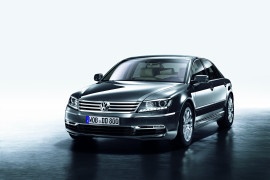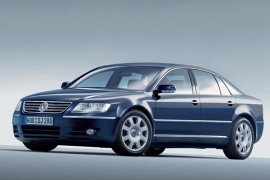
VOLKSWAGEN Phaeton
Generations Timeline, Specs and Pictures

The 2010 Phaeton was one of the most underrated vehicles of its time.
It had everything that a limousine needs and even more than most of the luxury cars had, but it still couldn’t make it into the premium segment.
Volkswagen rolled the dices with two vehicles: the Touareg and the Phaeton. While the Touareg was a hit and its sales were strong, the Phaeton didn’t make itself an entrance into the exclusive circle of the premium car manufacturers. It was Ferdinand Piech, the former chairman of the Volkswagen Group, that pushed the car onto assembly line with the desire to compete against the Mercedes-Benz S-Class in terms of luxury and amenities.
The first generation of the Phaeton was launched in 2002 and it shared the same platform with its luxury brother, the Bentley Flying Spur. Unfortunately, the styling was very close to the fifth generation of the Volkswagen Passat, but with a way longer wheelbase. At the time of launch, the Phaeton had the longest wheelbase in the brand’s lineup, for its LWB version.
Inside there was a long list of amenities that could outpace any S-Class. The attention to detail was huge. For instance, the air-vents were covered by wood trim and opened only when they were needed. The adjustable seatbelt’s height was electrically adjustable. The rear seats had an option for heating and ventilation. The twin insulated windows ensured better noise and climate protection.
The Phaeton was available with engines ranging between 240 hp and 450 hp mated to a 6-speed automatic transmission. For the safety systems, worth mentioning the Adaptive Cruise Control. That was uncommon for 2010.

Volkswagen introduced the Phaeton in 2002 as a direct competitor for luxury brands such as BMW and Mercedes-Benz.
Ferdinand Piech, the former Volkswagen CEO, pushed the company’s engineers to develop a luxurious vehicle under the VW brand. They used the same platform from the Audi A8 and built a different bodywork on top of it, resulting in the Phaeton. Another problem was with the nameplate. A phaeton used to be a sport version of an open-top carriage, and the German sedan was neither sporty nor convertible.
The 2005 Phaeton front side looked like an improved front fascia over a Volkswagen Passat B5 facelift from the same era. Its horizontally slated grille and horizontal headlights showed an improved design over its sibling but close enough to resemble it. The Phaeton’s profile, on the other hand, was different. Its C-pillar was thicker and wider on the lower side.
Since the Phaeton’s wheelbase was shorter than the one offered by the standard BMW 7-Series from the same era (the E65 model), which led to smaller legroom for the rear passengers than its competitor, still, it was more than enough for average-sized passengers. Since it was the most expensive Volkswagen to that date, it featured standard leather upholstery and wood-trims on the dashboard and door cards. A tall and wide center console separated the front occupants, while in the back, it was suitable for two passengers due to the transmission tunnel.
Volkswagen installed a wide engine range for the Phaeton SWB. For the base engine versions, either turbo-diesel or gasoline, the carmaker offered a standard front-wheel-drive system. It was a car suitable for fleets and even taxi drivers. A 5.0-liter V-10 oil-burner or a 6.0-liter W12 filled the engine compartment at the other end of the scale.

The Phaeton was the Volkswagen that shouldn’t exist, or at least not in 2002 when the German carmaker introduced it on the market.
Ferdinand Piech was in charge of the Volkswagen Group when he decided and pushed hard to introduce the Phaeton on the market in 2002. The carmaker had the A8 as a competitor against the S-Class from Mercedes and the 7-Series from BMW, but Piech asked for more. When the carmaker introduced the new model, the customers were confused. Even though it offered features unavailable for the A8, it was still wearing a Volkswagen badge. But the carmaker didn’t stop there. Two years later, it introduced the Phaeton with an extended wheelbase.
The Phaeton long featured a three-meter (118.1”) long wheelbase, visible especially on the rear doors, which were longer than on the regular version. Other than that, the exterior was similar to the regular Phaeton, with the same front fascia and thick C-pillar.
With a cabin long enough to park a SMART for-two between the dashboard and the rear bench’ seatback, the Volkswagen Phaeton featured increased legroom for the rear passengers of up to 1214 mm (47.8”). Despite its size, Volkswagen made it for up to four passengers due to the tall transmission tunnel and the low roofline. While it was the priciest car that wore a VW badge, it was less expensive than a Mercedes-Benz S-Class or a BMW 7-Series.
Under the hood, the carmaker installed a choice of three gasoline engines. The base model featured a 3.2-liter V-6, which was appropriate for fleet vehicles, while the top-spec version featured the W12 engine used on the Bentley Continental, but without turbochargers. Unlike the SWB Phaeton, the LWB version was available exclusively with all-wheel-drive.























































